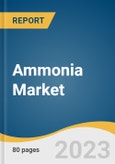The global ammonia market size is expected to reach USD 313.2 billion by 2030,. The market is expected to expand at a CAGR of 5.4% from 2023 to 2030. The growth is majorly driven by rising consumption of ammonia in fertilizers and refrigerants.
As the population of major countries around the world is projected to increase significantly, the demand for food will continue to rise, putting pressure on farmers to adopt more efficient methods of production. Ammonia-based nitrogenous fertilizers are poised to benefit from this trend as they offer increased yield, effective crop protection, and enhanced production cycles, making them a valuable tool for farmers facing the challenge of ensuring food security for an ever-rising global population.
NH3 is commonly used in large-scale refrigeration plants and is available in various forms such as liquid and gas. The advantage of using NH3 in refrigeration systems is that it costs 10-20% to produce compared to systems that use CFCs. In addition, according to the International Institute of Ammonia Refrigeration, ammonia is an efficient and cost-effective alternative to HFCs and CFCs and considered safe for the environment. Moreover, as per the U. S. Environment Protection Agency, the Global Warming Potential and the Potential of Ozone Depletion rating is almost null for NH3-based refrigerants.
Companies are more inclined toward producing sustainable/green NH3 as it has the potential to be a key component of a more sustainable, low-carbon energy system, as it can be used as a renewable fuel for transportation and power generation, as well as a zero-carbon feedstock for the production of fertilizers and other chemicals.
Moreover, companies like Yara International are focusing on developing sustainable product with the help of green hydrogen along with the production of conventional product. Moreover, the company is actively involved in cooperation with Statkraft & Aker Clean Hydrogen, with a goal of decarbonizing Yara’s NH3 plant by eliminating 800 kilotons of annual CO2 emissions.
As the population of major countries around the world is projected to increase significantly, the demand for food will continue to rise, putting pressure on farmers to adopt more efficient methods of production. Ammonia-based nitrogenous fertilizers are poised to benefit from this trend as they offer increased yield, effective crop protection, and enhanced production cycles, making them a valuable tool for farmers facing the challenge of ensuring food security for an ever-rising global population.
NH3 is commonly used in large-scale refrigeration plants and is available in various forms such as liquid and gas. The advantage of using NH3 in refrigeration systems is that it costs 10-20% to produce compared to systems that use CFCs. In addition, according to the International Institute of Ammonia Refrigeration, ammonia is an efficient and cost-effective alternative to HFCs and CFCs and considered safe for the environment. Moreover, as per the U. S. Environment Protection Agency, the Global Warming Potential and the Potential of Ozone Depletion rating is almost null for NH3-based refrigerants.
Companies are more inclined toward producing sustainable/green NH3 as it has the potential to be a key component of a more sustainable, low-carbon energy system, as it can be used as a renewable fuel for transportation and power generation, as well as a zero-carbon feedstock for the production of fertilizers and other chemicals.
Moreover, companies like Yara International are focusing on developing sustainable product with the help of green hydrogen along with the production of conventional product. Moreover, the company is actively involved in cooperation with Statkraft & Aker Clean Hydrogen, with a goal of decarbonizing Yara’s NH3 plant by eliminating 800 kilotons of annual CO2 emissions.
Ammonia Market Report Highlights
- The anhydrous dominated the market and accounted for revenue share of 60.1% in 2022. It is projected to expand at a highest growth rate of 5.8% from 2023 to 2030 owing to its ease of handling and abundant availability for the farmers
- The anhydrous form of product-based fertilizer is widely used in agriculture due to its high nitrogen content of 82%. However, it is more effective in warmer climates compared to cooler climates
- The fertilizers application segment of ammonia is anticipated to expand at a CAGR of 5.6% from 2023 to 2030 by revenue owing to the increasing adoption of ammonia-based fertilizers by farmers across the globe
- Asia Pacific is projected to reflect the fastest volumetric CAGR of 5.8% over the forecast period. This is attributed to large number of agrarian countries, including Thailand, Japan, India, Indonesia, and the Philippines, among other major agricultural-based economies
Table of Contents
Chapter 1 Methodology And Scope
Chapter 2 Executive Summary
Chapter 3 Ammonia Market Variables And Trends
Chapter 4 Ammonia Market: Suppliers Portfolio Analysis
Chapter 5 Ammonia Market: Product Form Estimates & Trend Analysis
Chapter 6 Ammonia Market: Application Estimates & Trend Analysis
Chapter 7 Ammonia Market: Regional Estimates & Trend Analysis
Chapter 8 Ammonia Market: Competitive Landscape
List of Tables
List of Figures
Companies Mentioned
- Acron
- Koch Fertilizer, LLC
- Yara
- CF Industries Holdings, Inc.
- Nutrien Ltd.
- QATAR FERTILISER COMPANY
- Togliattiazot
- SABIC
- Sumitomo Chemical Co., Ltd.
Methodology

LOADING...
Table Information
| Report Attribute | Details |
|---|---|
| No. of Pages | 80 |
| Published | May 2023 |
| Forecast Period | 2022 - 2030 |
| Estimated Market Value ( USD | $ 205.34 Billion |
| Forecasted Market Value ( USD | $ 313.2 Billion |
| Compound Annual Growth Rate | 5.4% |
| Regions Covered | Global |
| No. of Companies Mentioned | 9 |









